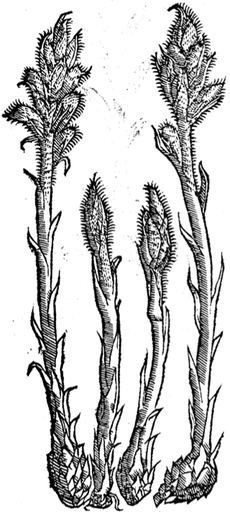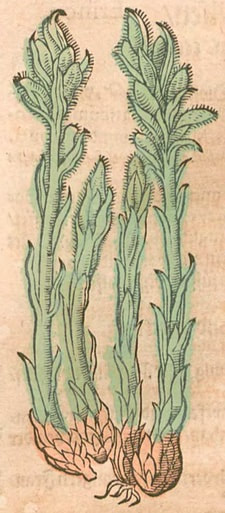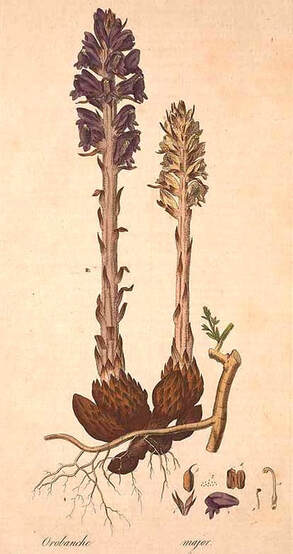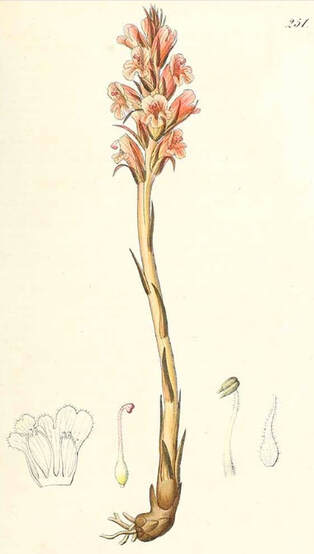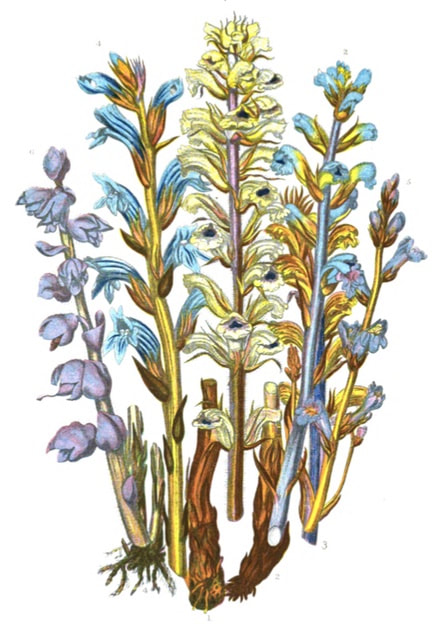Sentry Page Protection
Orobanche, Broomrape
Gro shang rtse གྲོ་ཤང་རྩེ (Tibetan Medicine)
Cao Cong Rong, Lie Dang (Sky-blue Broomrape, O. coerulescens, TCM)
Cao Cong Rong, Lie Dang (Sky-blue Broomrape, O. coerulescens, TCM)
|
Dioscorides Materia Medica, Mathias, 1563
|
Krauterbuch, Lonitzer, 1578
|
|
Orobanche Major (O. caryophyllacea)
Curtis, Flora Londinensis, vol. 4: 1781-1784 |
Orobanche alba
A.G. Dietrich, Flora regni borussici, vol. 4 (1836) |
A number of Broomrape varieties found in England and Europe including (from Left to Right)
Purple Broomrape, Greater Brromrape, Picris Broomrape, Lesser Broomrape and Ivy Broomrape
(Flowering Plants, Grasses, Sedges, Ferns of Great Britain, Pratt, Vol. II, 1899)
Purple Broomrape, Greater Brromrape, Picris Broomrape, Lesser Broomrape and Ivy Broomrape
(Flowering Plants, Grasses, Sedges, Ferns of Great Britain, Pratt, Vol. II, 1899)
Botanical name:
Orobanche spp.
A number of species appear to have been used similarly in different traditions:
Parts used:
Fleshy stem
Temperature & Taste:
Warm, dry. Sweet, slightly Bitter (Neutral in Tibetan Medicine)
Orobanche spp.
A number of species appear to have been used similarly in different traditions:
- O. major, O. minor, Greater and Lesser Broomrape (West)
- O. caryophyllacea, Clove-Scented Broomrape (West)
- O. rubra, Red Broomrape (U.K)
- O. elatior, Tall Broomrape (U.K.)
- O. purpurea (syn. O. coerulea), Purple Broomrape
- O. crenata (listed by Dioscorides)
- O. coerulescens (Lie Dang: TCM; Lug ru smug po: Tibetan Medicine)
- O. asciatica (Shang rtse, Tibetan Medicine)
- O. cernua, O. megalantha (Sgro shang rtse; Tibetan Medicine)
- O. alba (Sngo gro shang rtse, Tibetan Medicine)
Parts used:
Fleshy stem
Temperature & Taste:
Warm, dry. Sweet, slightly Bitter (Neutral in Tibetan Medicine)
Uses:
1. Warms the Kidneys, Strengthens Yang, Promotes Urine: (West, TCM, Tibet)
-Edema, Fluid retention
-Gravel, Stones (West)
-Impotence, Aphrodisiac; Spermatorrhea
-Infertility associated with Cold and Weakness of the Uterus (TCM)
-fresh young shoots are boiled and eaten like Asparagus (Dioscorides)
2. Strengthens Sinews and Bones: (TCM, Tibet)
-Lower Back pain and weakness
-Weakness of the Bones and Joints
-Chronic joint disease associated with Kidney weakness
3. Opens Obstructions, Moves the Bowels: (West, TCM, Tibet)
-Liver obstruction; Jaundice
-Spleen diseases, Melancholy (candied herb or root)
-Hypochondriac pain
-Colic
4. Stops Bleeding: (Tibet)
-Bleeding of various types; especially excessive Menstruation
-ruptured Blood vessels
-Chronic hard-to-heal Wounds
5. Externally:
-Fresh Wounds, Old and Malignant Ulcers (fresh juice)
-triple-infused oil or juice is applied to remove all skin-spots, sun-spots, freckles and marks
-as an ointment (with lard) to resolve all hard swellings of the body
-topically to Toothache
-Burns (Tibetan Medicine)
Dose:
Decoction: 3–9 grams
Powder: 1–3 grams
Comment:
1. Orobanche (Broomrape) is similar to 2 medicines used in TCM; Cistanche Rou Cong Rong (which is also known as Broomrape) and Cynomorium Suo Yang. All are parasitic, growing on the roots of various plants. The two species used in Chinese Medicine are similar in effect, both regarded as Yang tonics which also nourish the Essence and Blood. In addition, they have a gentle laxative effect. While there is little indication for the tonic use of Orobanche in the West, its use in Kidney disorders and to open obstructions suggests similar effects. In addition, in Tibetan Medicine Orobanche is used to warm the Kidneys, treating Impotence, Kidney and Lower back pain, and to strengthen the Back and Joints (Drungtso). This suggests Orobanche can be used similarly to its Eastern relatives.
2. Gerard and others noted some of the Satyrions (Orchid spp.) and Orobanche were very similar in appearance. Satyrions were highly regarded as Kidney tonics and Aphrodisiacs in the west.
Substitutes:
1. Cistanche Rou Cong Rong
2. Cynomorium Suo Yang
Decoction: 3–9 grams
Powder: 1–3 grams
Comment:
1. Orobanche (Broomrape) is similar to 2 medicines used in TCM; Cistanche Rou Cong Rong (which is also known as Broomrape) and Cynomorium Suo Yang. All are parasitic, growing on the roots of various plants. The two species used in Chinese Medicine are similar in effect, both regarded as Yang tonics which also nourish the Essence and Blood. In addition, they have a gentle laxative effect. While there is little indication for the tonic use of Orobanche in the West, its use in Kidney disorders and to open obstructions suggests similar effects. In addition, in Tibetan Medicine Orobanche is used to warm the Kidneys, treating Impotence, Kidney and Lower back pain, and to strengthen the Back and Joints (Drungtso). This suggests Orobanche can be used similarly to its Eastern relatives.
2. Gerard and others noted some of the Satyrions (Orchid spp.) and Orobanche were very similar in appearance. Satyrions were highly regarded as Kidney tonics and Aphrodisiacs in the west.
Substitutes:
1. Cistanche Rou Cong Rong
2. Cynomorium Suo Yang
Main Combinations:
Cautions:
None noted
Toxicity
"Orobanche spp. are non-toxic in a wide concentration range" (see here)
Main Preparations used:
None noted
Toxicity
"Orobanche spp. are non-toxic in a wide concentration range" (see here)
Main Preparations used:
Click the Tabs above for more information on this Medicine
GENERAL / REVIEW
–The genus Orobanche as food and medicine: An ethnopharmacological review.
–[Pharmacophylogenetic study of genus Orobanche, Cistanche and Boschniakia].
–[Investigation of ethnic medicinal plants Orobanche, Cistanche and Boschniakia].
ANTIBACTERIAL
–In vitro evaluation of biological activities of Orobanche crenata Forssk. leaves extract.
ANTI-FUNGAL
–Anti-Candidal Activity of the Parasitic Plant Orobanche crenata Forssk.
ANTIOXIDANT
–In vitro evaluation of biological activities of Orobanche crenata Forssk. leaves extract.
ANTI-INFLAMMATORY
–In vivo anti-inflammatory and hepatoprotective activities of Orobanche crenata (Forssk.) aerial parts in relation to its phytomolecules.
IMMUNOSTIMULATING
–[Pharmacodynamic effects of the extracts from Orobanche cumana].
HEPATOPROTECTIVE
–In vivo anti-inflammatory and hepatoprotective activities of Orobanche crenata (Forssk.) aerial parts in relation to its phytomolecules.
ANTI-FATIGUE
–[Pharmacodynamic effects of the extracts from Orobanche cumana].
ANDROGENIC
–The genus Orobanche as food and medicine: An ethnopharmacological review.
DIABETES
–Phytochemical screening, antiobesity, antidiabetic and antimicrobial assessments of Orobanche aegyptiaca from Palestine.
OBESITY
–Phytochemical screening, antiobesity, antidiabetic and antimicrobial assessments of Orobanche aegyptiaca from Palestine.
–The genus Orobanche as food and medicine: An ethnopharmacological review.
–[Pharmacophylogenetic study of genus Orobanche, Cistanche and Boschniakia].
–[Investigation of ethnic medicinal plants Orobanche, Cistanche and Boschniakia].
ANTIBACTERIAL
–In vitro evaluation of biological activities of Orobanche crenata Forssk. leaves extract.
ANTI-FUNGAL
–Anti-Candidal Activity of the Parasitic Plant Orobanche crenata Forssk.
ANTIOXIDANT
–In vitro evaluation of biological activities of Orobanche crenata Forssk. leaves extract.
ANTI-INFLAMMATORY
–In vivo anti-inflammatory and hepatoprotective activities of Orobanche crenata (Forssk.) aerial parts in relation to its phytomolecules.
IMMUNOSTIMULATING
–[Pharmacodynamic effects of the extracts from Orobanche cumana].
HEPATOPROTECTIVE
–In vivo anti-inflammatory and hepatoprotective activities of Orobanche crenata (Forssk.) aerial parts in relation to its phytomolecules.
ANTI-FATIGUE
–[Pharmacodynamic effects of the extracts from Orobanche cumana].
ANDROGENIC
–The genus Orobanche as food and medicine: An ethnopharmacological review.
DIABETES
–Phytochemical screening, antiobesity, antidiabetic and antimicrobial assessments of Orobanche aegyptiaca from Palestine.
OBESITY
–Phytochemical screening, antiobesity, antidiabetic and antimicrobial assessments of Orobanche aegyptiaca from Palestine.

